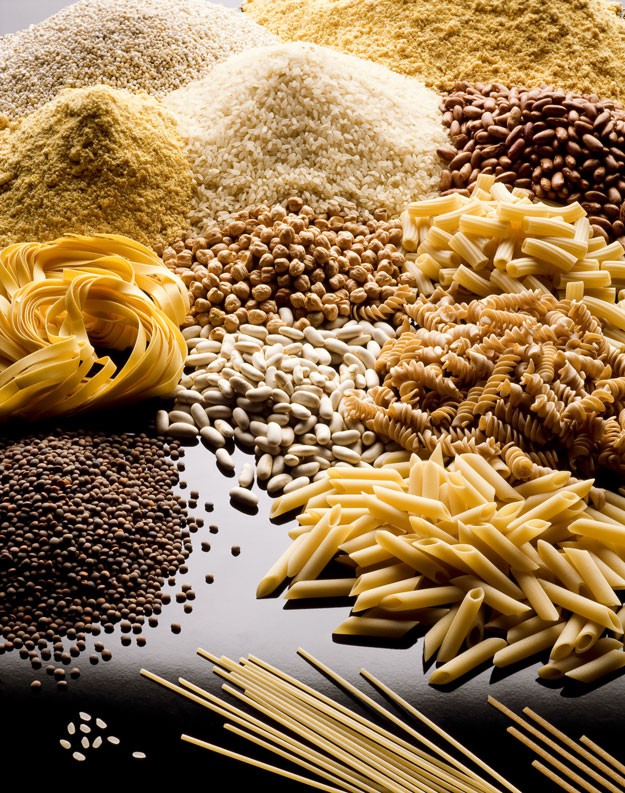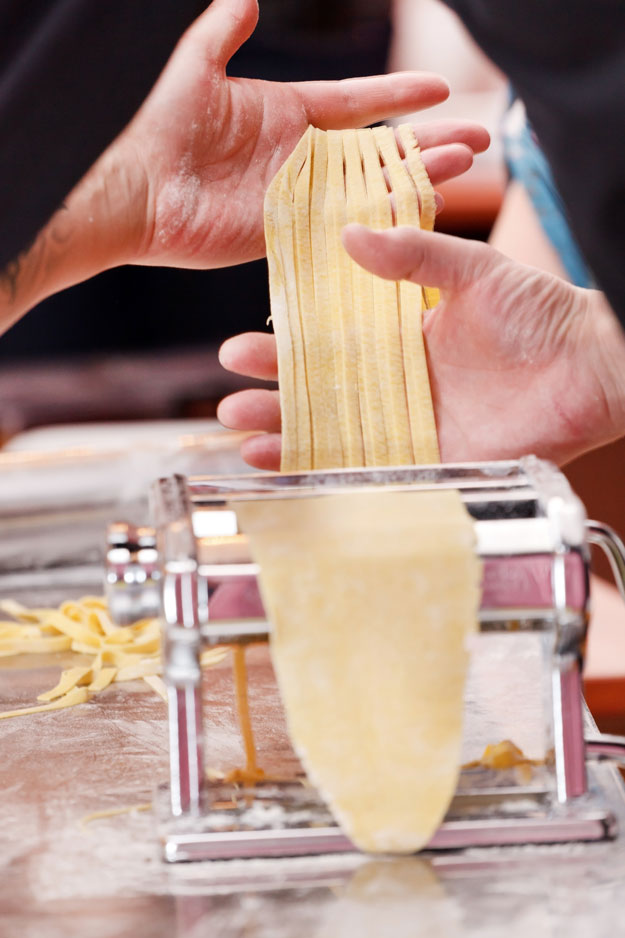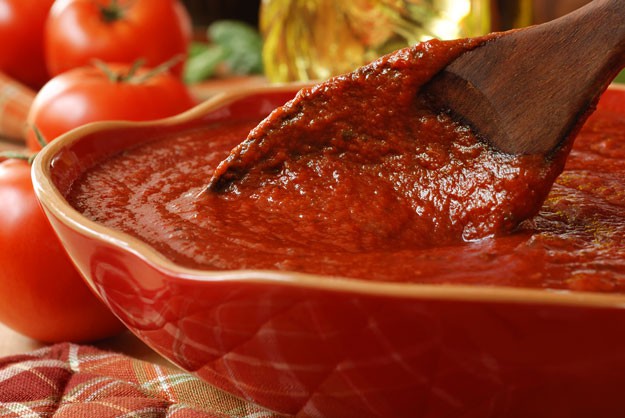Welcome back to our comprehensive guide on How To Be A Master Chef for beginners and food enthusiasts! In today’s posts, we’ll go over one of the most important parts in any meal: pasta and grains! Learn the different kinds of pasta and grains, and how to cook them to perfection! We even include a classic pasta sauce recipe to practice with and enjoy! We’re halfway there to being a master chef, so let’s get started!
Did you miss our previous posts in the How To Be A Master Chef in 10 Days series? Catch up with this guide on How To Make Soups, Purees and Bisques The Entire Family Can Enjoy!
Perfect Pasta & Grains: Sides & Mains

Carbs, carbs, carbs! We love carbs! Grains have been a major part of the human diet since the dawn of time, meaning rice, barley, wheat, oats, cornmeal, quinoa, and other grains have always been a great way to get the nutrition we need! This guide goes over how to prepare your grains and pasta in a way that will tantalize the taste buds.
Nice Rice Made Once Or Twice
Nearly every culture out there prepares rice in one way or another so it must be great! There are tons of different rice dishes and over 1,100 different types of rice. Here is a list of areas found throughout the world and what they like to add to their rice. Try these out:
India: Curry and spices such as coriander, cardamom, fennel, cumin
Middle East: Onions, cinnamon, allspice, raisins, cardamom, turmeric
Louisiana: Onions, garlic, cayenne, bell peppers, okra, spicy sausage
Spain: Nuts, saffron, vegetables, garlic
Mexico: Hot peppers, garlic, pinto or black beans, onions
In the United States, we typically use these types of rice:
Short-Grain Rice: This is rice that comes in either brown or white, and it is shorter than other types of rice. People use this in their sushi, and it is delicious!
Long-Grain Rice: This type of rice is either brown or white and has a longer grain than other types of rice. You’ll see this used a lot in the states!
Converted Rice: This is when you take whole grains of rice and soak them in water, steam them, and dry them. Through this process, you will be able to conserve the nutrients your body needs. Steaming the rice will also take away a lot of the starch found in rice, allowing you to create rice that is smooth and quick to make!
Instant Rice: As the easiest type of rice to make, this rice is precooked and dried out to make it a quick meal for anyone with limited time to cook. This is not as delicious as rice that is cooked once, but it is still very good!
We recommend choosing brown rice over white rice every time because of the nutrients found in it. White rice has the nutritious bran layer removed during the brown rice still has this layer intact!
Grain Knowledge For Novices

Rice is not the only grain that we suggest you make… Here is a list of other common grains that will get you going:
Buckwheat: This is actually a grass, but it is very similar to grain and is used as one. Buckwheat tastes similar to brown rice and is great with any dish!
Barley: Toss this grain in your soups or use it as a side dish. If you want to have the nutrients, make sure to avoid buying pearl barley because the nutrients are removed. Put some butter, black pepper, and salt with this grain and you have yourself a delectable side dish.
Farro: Eating this grain is a unique experience because of the chewy texture it possesses. There is a lot of fiber found in it, making it great for anyone to eat daily!
Couscous: The food so nice they named it twice! This is typically used throughout North Africa. People take this grain and put it with various herbs, spices, and sauces to make great dishes in bulk.
Oats: Oats are used for breakfasts. You’ll find oats boiled in water to make oatmeal. People add some sugar or honey and enjoy this grain for breakfast.
Quinoa: Health food stores sell this stuff like wildfire! This Middle Eastern grain has gained a lot of popularity over the years, and it tastes great!
Cornmeal: This grain is not very common, but it is used to make a breakfast side dish you might know of. Grits are made with cornmeal and grits are great! Make sure to try out some grits the next time you grab breakfast!
Become Passionate About Pasta

Looking for a quick meal that will satisfy a horde of people? Start making pasta! Pasta is unique because there are so many different ways to prepare it. All you really need to do is cook the pasta until it is the desired consistency and top it with various meats, veggies, cheeses, sauces, or a combination! Pasta is an easy-to-make dish that is fun to eat! This is one of the staple foods found in the United States, and nearly every culture has their own version of it. This section will go over the differences between boxed and homemade pasta, and the various types of pasta.
Boxed Versus Homemade
Some people might prefer fresh to boxed pasta, but there really isn’t that big of a difference. You can try making your own, or you can stick to the boxed stuff. The added time may or may not be worth it to you so just cook it based off of your own preferences. Fresh pasta is lighter and more delicate, but the choice is really up to you.
When cooking pasta, try these tips to make your life easier:
- Toss the pasta at the wall and see if it sticks. It the pasta sticks, it is done cooking. If the pasta ends up on the floor, cook it for a bit longer.
- Try checking if your pasta is done by taking a strand of it and throwing it in the air to let it cool a little. Taste the pasta and see if it tastes done.
- Make sure to use plenty of water when making pasta. You will strain the water out so don’t worry about soggy pasta.
- Salt the water. Salting water gives flavor and assists in the pasta absorbing sauce. Use around 2 teaspoons of salt for every 5 quarts of water. If you are using 6 quarts of water, try using a tablespoon of salt.
- After adding the pasta to the water, make sure to stir it immediately. If you don’t, the pasta can stick together.
- Keep the pot covered to allow it to heat back up. When you add pasta to boiling water, the water stops boiling. You want the water to boil, meaning put that lid on! Also, watch to make sure the pasta does not boil over. A good trick for that is to take a wooden spoon and put it over the diameter of the pot. The bubbles will rise and dissipate once they touch the spoon!
- Don’t rinse your pasta! The starch on the pasta helps the sauce stick to it. The only time you should rinse it is when you are making a lasagna or pasta salad.
- Take the drained pasta and put it in a pan with your sauce. Stir the pasta around to coat it. This works better than simply putting the sauce on top because it allows the sauce to cover all of your pasta.
- Make sure to cook the sauce prior to cooking the pasta. Once the sauce is ready to add to the pasta, you can start making the pasta. If you cook the pasta first, you will have it sitting around, and it will become stiff.
Types Of Pasta
Pasta comes in all different shapes. You should try all of these out to see which ones you prefer:
Spaghetti: These string-like strands of pasta are generally accompanied by cream or tomato sauces. There are also people who put pesto in their spaghetti.
Macaroni: This tube-shaped pasta is generally served with thick and rich sauces. Have you heard of macaroni and cheese? Well, this is it!
Linguine & Fettuccine: These are flat spaghetti strands. They are usually served in creamy sauces. For example, Fettuccine Alfredo. Deliciousness!
Ravioli: This pasta is stuffed with either cheese, meat, fish or vegetables and covered in tomato or cream sauces. Sometimes the dough is infused with tomato, mushrooms, spinach, or spices.
Perfected Pasta Sauce

No one wants plain pasta; that’s why you need to make a sauce! If you don’t want to make one from scratch, go buy a jar or two and toss in your own unique ingredients to make it your own! When making pasta sauce, here are some tips to remember:
Stir the sauce as often as possible to avoid burning sauce at the bottom.
Each person you are feeding will probably eat around ½ cup of sauce.
Add some sugar to your sauce if you want it a little sweeter (grated carrot works well too!).
Put a tablespoon of olive oil for flavor in tomato sauces.
Try adding one or two of these ingredients to your jar of sauce: sliced olives, a cup of white beans, some crumbled bacon, sliced smoked sausage, freshly grated Parmesan cheese, small cooked shrimp.
Sauces
We’ve all been to Italian restaurants and had pasta, but have you ever wondered what was in those scrumptious sauces? Check these out:
Ragu all Bolognese: Ground beef, pork, veal, or a combination, tomatoes, and spices. Milk and wine are also involved in this sauce.
Alfredo: Cream, Parmesan cheese, butter, and white or black pepper.
Puttanesca: Garlic, tomatoes, capers, black olives, and anchovies.
Carbonara: Crisp bacon, eggs, garlic, cream, and Parmesan cheese.
Primavera: Sauteed spring vegetables and herbs.
Pesto: Pine nuts, garlic, olive oil, Parmesan cheese, and fresh basil leaves thrown into a blender to create a paste.
Marinara: Slow cooked tomato sauce with garlic, oregano, and basil. People typically toss some meatballs, mushrooms, ground meat, and vegetables in it to add some flare.
Follow the Table of Contents to catch up on our series or refresh your culinary memory:
Chapter 1: Be A Master Chef in 10 Days
Chapter 2: Kitchen Storage Ideas
Chapter 2.1: Main Kitchen Appliances
Chapter 2.2: Creating a Safe and User-Friendly Kitchen
Chapter 2.3: Essential Pots, Pans and Cookware
Chapter 3: How To Organize and Stock Your Kitchen Pantry
Chapter 4: How To Buy and Use Your Kitchen Knives
Chapter 4.1: Knife Cuts – Chopping, Dicing and More
Chapter 5: How To Steam, Boil, Poach and More
Chapter 6: How To Saute and Make Homemade Sauces
Chapter 7: How To Braise Meat and How To Make Stew
Chapter 8: How To Roast Meat, Veggies and Poultry
Chapter 9: How To Grill Steak, Chicken and Veggies
Chapter 10: How To Bake Goods and Desserts From Scratch
Chapter 10.1: How to Make Pie Crust, How To Bake Cakes and More!
Chapter 11: Cooking for Beginners – Breakfast
Chapter 11.1: Breakfast Bread – How To Make French Toast, Pancakes & Waffles
Chapter 13: How To Cook Perfect Pasta and Hearty Grains
Chapter 14: How To Make Sauces From Scratch
Chapter 15: Easy To Make Homemade Desserts For Beginners
Chapter 16: How To Make Single-Pot Recipes From Scratch
Chapter 17: Thinking Like A Chef – Cooking Tips for Beginners
Don’t forget to catch the next part of our guide to How To Be A Master Chef In 10 Days! We love hearing your feedback and comments, so let us know if you have any other tips for beginner cooks or your thoughts on this series. HomemadeRecipes.com was founded to create an online community where foodies, epicureans and chefs can share recipes and learn new ones! We need your help, however, in creating this community where you can come, share and learn. If you love to cook, love food or have some great recipes and ideas you’d like to share with us, shoot us an email and make sure to stay in touch on Facebook, Twitter, and Pinterest! We’re always looking for contributors and want to hear from you.
Sign up for our daily newsletter here!
Do you have Instagram? Don’t forget to follow @HomemadeRecipesOfficial.
Click here to Like Us on Facebook.
Click here to Follow Homemade Recipes on Pinterest



[…] How To Be A Master Chef In 10 Days – Pasta & Grains […]